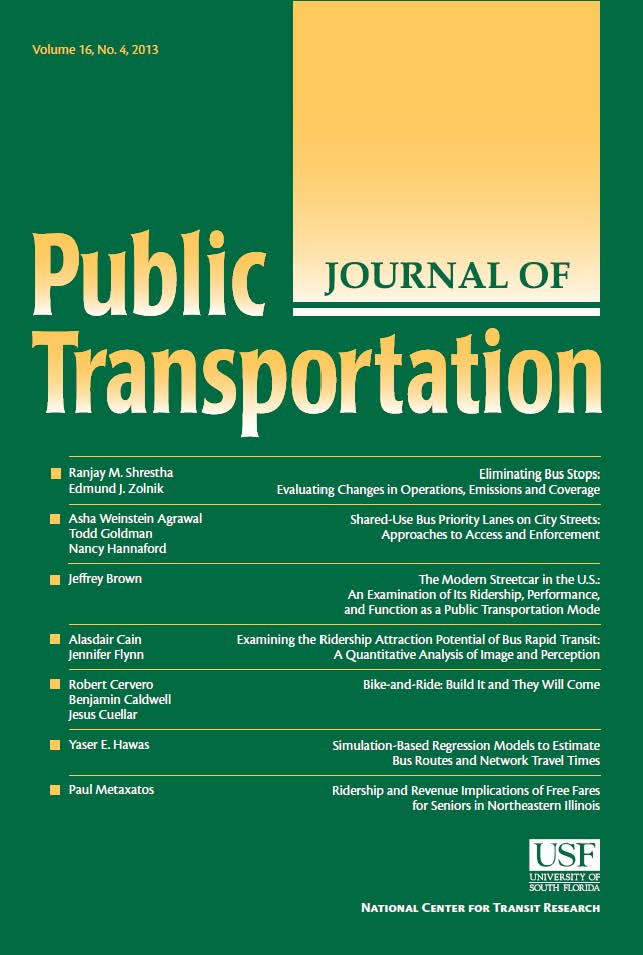Measuring transit service reliability at the route level? Exploring the relationship between reliability measures and ridership
IF 2
4区 工程技术
Q3 TRANSPORTATION
引用次数: 0
Abstract
Transit agencies are in a consistent struggle to offer an attractive service that draws a higher level of ridership. To improve the attractiveness of the service, one of the key objectives of agencies is to enhance transit service reliability. Service reliability refers to service punctuality and adherence to schedule. A considerable number of studies have focused on understanding the general factors affecting reliability. Nevertheless, it is rare to find studies that explore the association between different reliability measures and transit usage at the route level. Therefore, the aim of this study is to assess how different reliability measures relate to public transit-usage and which measures best explain variations in transit ridership. In total, 22 transit reliability measures that ranged from on-time performance (OTP) measures to service variation measures were assessed. Using land-use, socioeconomic, and detailed ridership datasets, in addition to data obtained from Winnipeg Transit’s Automated Vehicle Location (AVL) system, random coefficients mixed-effect models were estimated at the route level. The results show that, generally, deviation-based measures performed better than OTP measures in explaining transit ridership at the route level. The reliability measure of absolute deviation at terminals performed best in predicting variations in transit ridership, while controlling several influential factors. More importantly, the improvements in predication of ridership due to the use of reliability measures varied according to route’s ridership. This study offers planners and policymakers helpful insights into understanding the relationship between transit service reliability measures of choice and transit ridership at the route level of analysis.
在路线层面衡量交通服务的可靠性?探索可靠性措施与客流量之间的关系
公共交通机构一直在努力提供有吸引力的服务,吸引更多的乘客。为了提高过境服务的吸引力,各机构的主要目标之一是提高过境服务的可靠性。服务可靠性是指服务的准时性和对计划的遵守。相当多的研究集中在了解影响可靠性的一般因素。然而,很少有研究在路线水平上探讨不同可靠性措施与过境使用之间的关系。因此,本研究的目的是评估不同的可靠性测量与公共交通使用的关系,以及哪种测量最能解释交通客流量的变化。总共评估了22个交通可靠性指标,从准点率(OTP)指标到服务变化指标。利用土地利用、社会经济和详细的乘客数据集,以及从温尼伯运输公司的自动车辆定位(AVL)系统获得的数据,在路线层面估计了随机系数混合效应模型。结果表明,总体而言,基于偏差的度量在解释路线层面的公交客流量方面优于OTP度量。在控制多个影响因素的情况下,码头绝对偏差的可靠性度量在预测客流量变化方面表现最好。更重要的是,由于可靠性措施的使用,客运量预测的改进根据路线的客运量而变化。该研究为规划人员和政策制定者提供了有益的见解,帮助他们理解在路线分析层面上选择的公交服务可靠性措施与公交客流量之间的关系。
本文章由计算机程序翻译,如有差异,请以英文原文为准。
求助全文
约1分钟内获得全文
求助全文
来源期刊

Journal of Public Transportation
TRANSPORTATION-
CiteScore
6.40
自引率
0.00%
发文量
29
审稿时长
26 days
期刊介绍:
The Journal of Public Transportation, affiliated with the Center for Urban Transportation Research, is an international peer-reviewed open access journal focused on various forms of public transportation. It publishes original research from diverse academic disciplines, including engineering, economics, planning, and policy, emphasizing innovative solutions to transportation challenges. Content covers mobility services available to the general public, such as line-based services and shared fleets, offering insights beneficial to passengers, agencies, service providers, and communities.
 求助内容:
求助内容: 应助结果提醒方式:
应助结果提醒方式:


